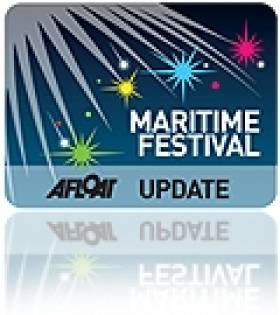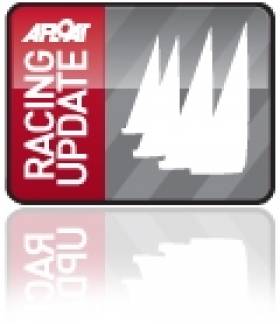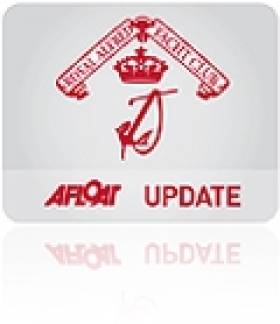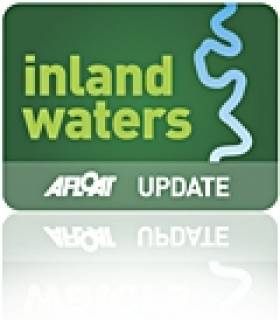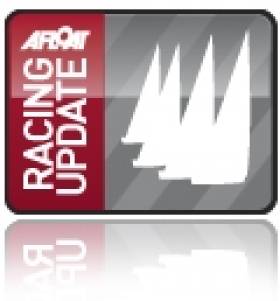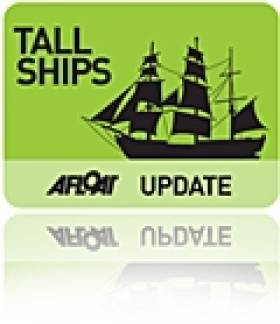Displaying items by tag: Bloomsday
The Irish Naval Vessel LÉ James Joyce was positioned off Sandycove Point on Dublin Bay for over an hour today, close to the Martello Tower made famous by Irish writer James Joyce in his novel Ulysses.
The special Bloomsday tribute was made by the ship that was named after the author in 2015.
LE James Joyce departed Dún Laoghaire Harbour at 1430hrs and made its way across Scotsman's Bay where there were a number of shoreside Joycean gatherings being held.
Bloomsday celebrates Joyce's iconic Ulysses through performances, meals, readings, and dressing-up, especially at Sandycove.
As part of the celebrations, LÉ James Joyce flew "the oldest flag afloat, the flag of the province of Desmond & Thomond, three crowns on a blue field, the three sons of Milesius," as Joyce describes in Ulysses.
 The Irish Naval Vessel LÉ James Joyce (left) was positioned off Sandycove Point on Dublin Bay, close to the Martello Tower (right) on Bloomsday.
The Irish Naval Vessel LÉ James Joyce (left) was positioned off Sandycove Point on Dublin Bay, close to the Martello Tower (right) on Bloomsday.
The Napoleonic tower is where the author spent six nights in 1904. The opening scenes of his 1922 novel Ulysses take place there, and the building is a place of pilgrimage for Joyce enthusiasts, especially on Bloomsday.
'Erin's King'- a Joycean Steamship on Bloomsday
On the 16th June each year people come from far and wide dressed in Edwardian attire to walk, talk and perform around Dublin in commemoration of James Joyce's famous modernist novel "Ulysses". You see lots of bowler hats, parasols and long dresses but you never spot an Edwardian Captain or even a haggard sea-dog in the crowd. This is surely a surprising outcome for a book which is the modern reliving of the adventures of a great sailor i.e. Odysseus and his ten-year voyage home from Troy.
It's not as if ships and the sea don't feature in Ulysses. The book is teeming with marine allusions, references and characters which, given Joyce's capacity for inch-perfect description, can be relied upon to hold many satisfying insights. Take the case of the steamship Erin's King.
The Erin's King arrives into the novel as Leopold Bloom reflects on a letter from his daughter Milly who has just celebrated her fifteenth birthday -
"On the Erin's King that day round the Kish. Damned old tub pitching about. Not a bit funky. Her pale blue scarf loose in the wind with her hair."
Later the ship returns to Bloom's thoughts as he crosses O'Connell Bridge -
"Looking down he saw flapping strongly, wheeling between the gaunt quay walls, gulls…They wheeled lower. Looking for grub. Wait. He threw down among them a crumpled paper ball… The ball bobbed unheeded on the wake of swells, floated under by the bridge piers. Not such damn fools. Also the day I threw that stale cake out of the Erin's King picked it up in the wake fifty yards astern. Live by their wits. They wheeled, flapping".
That evening he sits at Sandymount strand near St. Mary's, Star of the Sea, church. Noticing the distant twinkle from the Kish lightship he again recalls the trip with Milly -
"Day we went out for the pleasure cruise in the Erin's King, throwing them the sack of old papers. Bears in the zoo. Filthy trip. Drunkards out to shake up their livers. Puking overboard to feed the herrings. Nausea. And the women, fear of God in their faces. Milly, no sign of funk. Her blue scarf loose, laughing. Don't know what death is at that age."
Was there ever a real ship named Erin's King? An examination of Lloyd's register for 1904 (the year in which Ulysses is set) reveals no such vessel. It requires a wider trawl of thirty-five years of Lloyds to reveal her full story.
For the greater part of her life she was named Heather Bell. Built in 1865 by T. Vernon & Son of Liverpool she was a twin funnel vessel, 159.8ft in length with paddles to stern, a steam engine rated at 80 horsepower and registered tonnage of 205. She was owned by Wallasey Local Board and worked as a Mersey Ferry on the Wallasey to Liverpool route. Heather Bell had a reputation as a good ship.
In 1891 her ownership changed to an individual named Ward who registered her with Lloyds as "Erin's King (ex Heather Bell)". Thereafter she operated as an excursion steamer taking sightseers out around Dublin Bay.
Erin's King berthed at Custom's House Quay and travelled out as far as the Kish lightship to the south and northwards to Ireland's Eye island. The fare was a shilling and she sailed several times a day in the Summer.
In the Lloyd's Register for 1901, her details are overprinted with a stamp "Broken up 00". Erin's King ex Heather Bell was dismantled on the Mersey not far from where she was built.
From the above, we can see that Bloom's trip on Erin's King had to be some years before 1904 and that the fictitious Milly Bloom would have been a young child when they rounded the Kish. The point for the reader is that the ship and the excursions are already in the past and that as Milly moves into adolescence Bloom is making a fatherly recall of her as a child. That Joyce intended this is clear from the words "Don't know what death is at that age".
The final mention of Erin's King is in the Nighttown episode where Bloom's deepest fears, anxieties and guilt rise up in a series of fierce assaults on his mind. It occurs in a single sentence which Joyce has placed in parenthesis and italics in the manner of a stage direction.
"(Far out in the bay between Bailey and Kish lights the Erin's King sails, sending a broadening plume of coalsmoke from her funnel towards the land.)"
It is the last we see of Erin's King as she sails into eternity.
Footnote
Erin's King which features in James Joyce's in Ulysses is pictured at the top of this page. She is shown here in her original manifestation as a Mersey Ferry, Heather Bell. When launched in 1865 she cost £7,500 to construct. She was sold in 1891 for £950 and renamed Erin's King.
The author is researching the Erin's King and would be interested in hearing from anybody who has items, photos, material or information about the ship and/or the St. George Steam Tug Company, Dublin. Contact him below by email.
Works consulted for this article were:
- Ulysses by James Joyce. The 1934 text, as corrected and reset in 1961, The Modern Library. Quotations are from pages 67,152,379 and 550.
- Ulysses annotated, Notes for James Joyce's Ulysses. Don Gifford with Robert J. Seidman (Author). University of California Press, Berkeley 94704.
- Website: History of Wallasey Ferries
- Lloyds Register of Shipping Online
- The Coming of the Comet – The Rise and Fall of the Paddle Steamer. (2012) Nick Robins (Author). Seaforth Publishing.
Dun Laoghaire's In Bloom For James Joyce Celebrations
#Festivals - A host of events are lined up in Dun Laoghaire to celebrate Bloomsday leading up to the day itself next Monday 16 June.
Three days of Bloomsday Breakfasts begin on Saturday 14 June, but the fun lasts all day with music by Jhil Quinn’s Cafe Vaudeville Band, giant street games like Jenga and chess, and a vintage carousel at the waterfront.
The weekend will also feature readings from James Joyce's Ulysses by professional actors throughout Dun Laoghaire, as well as walking tours taking visitors around some of the sites frequented by the author and mentioned in his most famous work.
One of these is the famed James Joyce Tower in Sandycove, which will be connected with Dun Laoghaire town centre and Glasthule village and the renowned Teddy's Ice Cream shop by a free vintage shuttle bus.
The Joyce Tower itself is hosting a range of events from this Thursday 12 June, which will see a performance of Molly Bloom's soliloquy, while the Saturday will see free guided tours of the tower and museum in Joycean dress.
And what's more, all of these festivities will be happening against the backdrop of the ICRA Nationals at the Royal Irish Yacht Club on Sunday.
Racing Updates: RAYC Bloomsday, Mermaid, IRC Cowes, Wags, Lasers, Fireballs, Ruffians, Ailsa Craig
#regattas – After a week of rain and gales there was a full programme of yachting round the coast at the weekend with one of the biggest fleets racing for RAYC Bloomsday regatta honours at the National Yacht Club in Dun Laoghaire. From the same club the clinker Waterwags celebrated 125 years of racing on Dublin Bay with a 20–boat fleet and a Victorian high tea yesterday afternoon. There were celebrations too further up the east coast for K. Halliwell's 'She of the North' who won the fiftieth round Ailsa Craig race from the Royal Ulster Yacht Club.
Antrim sailor Chris Penney won the Laser Leinsters at Howth and in a possible sign of good things to come ISAF Youth Rep Finn Lynch of the National YC won the radial division. The Ruffian 23s raced for national honours on Dublin Bay and 20 Fireballs turned up to race for Ulster honours at East Down Yacht Club.
In Cowes, Royal Cork's Anthony O'Leary, who finished second last weekend in the 1720 Nationals on home waters, was second overall again yesterday in IRC one class at a windy British National Cruiser Championships. Great onboard action video from Cowes here.
And finally, if you are on the south coast this week and see a small half decked Mermaid dinghy take the time to say hello. She is currently in Crookhaven, West Cork heading east so expect to see her in Cork harbour this week or next! The clinker built Thumbalina is cruising round the coast from Foynes on the Shannon Estuary to Skerries in North Dublin as part of the eightieth celebrations of the traditional Dublin Bay class.
#bloomsday – Twenty sailing classes and 118 entries took to Dublin Bay to race for the Royal Alfred's (RAYC) historic trophies for this year's Bloomsday regatta writes Ailbe Millerick. The weather forecast was mixed and yielded 10-15 knots of breeze during the first race on the windward leeward courses laid ably by Hal Bleakley, Gordon Davies and Commodore Barry MacNeaney and their teams.
The wind strengthened considerably in the rains squalls that traversed the race courses and the second race witnessed a number of broaches down the runs as the breeze piped up to over twenty gusting twenty eight knots. Most class winners didn't quite go to form with notable exceptions.
The regatta was both challenging for the competitors and rewarding for those that survived the demanding weather conditions. Wind Guru was forecasting 14 to 16 knot westerlies gusting 18 knots at times. Met Eireann was predicting force 5 to 7 with the stronger winds in the afternoon - and boy, were they right! Hal Bleakley, PRO on Course A for Cruisers 0, 1, 2 and White Sails set windward leeward courses that called for different skills than those that the Helms are used to when racing around the Dublin Bay Marks.
The frequent rain squalls reduced visibility to less than 100 metres at times.
For the second race Hal increased the number of rounds and in a yachtmans' gale boats and crew were tested. Certainly the stories in the bar afterwards were not the usual exaggerations, but accurate retelling of the conditions endured.
Barry MacNeaney, PRO on Course B for Dragons, Shipmans, Cruiser 3, Benateau 21 and Glens set a long course for the first race that saw some classes barely finishing within the time limit, as despite the 20 knot plus wind a very strong ebb tide made the beat back to the finish an uphill struggle. With the wind increasing he shortened the course for the second race. There were some exciting downwind broaches with "Quest" practically putting her mast in the water on the downwind leg of the first round. Obviously not learning from her experience the spinnaker was again hauled up on the downwind leg of the second round, resulting in an even more spectacular broach that followed an hypnotic rolling that started as a slight swing of the mast but increased till the yacht was going through 60 degrees side to side and the inevitable happened. It is to the crew's credit that within a matter of seconds the boat was back on course and racing hard again.
Brian O'Hare won the Squibs and Denis Bergin upset Edinburgh Cup holder Martin Byrne in the Dragons. Great celebrations were had on veteran Liam Shanahan's Emir Herr beating Philip Dilworth's Orna steered by Brian Mathews who took the IRC handicap.
The ladies were to the fore with Anne Kirwan winning the Ruffians and Christine Heath's well reefed Shipman winning the tie break with Viking while her sisters Mary and Angela were runners up in the Squib Class. Overall it was a good days yachting after an awful week of rain and gales.
All Classes finished comfortably within the time limits and were no doubt glad to head for the shelter of the Harbour.
Gordon Davies was the PRO for the dingy classes and he set some excellent courses that gave the competitors ample opportunity to display their heavy weather skills. A comment of thanks from Ronan Beirne of the Flying Fifteen class said it was one of the best day's sailing they had enjoyed this year year and was of Championship standard.
The Alfred would like to thank all the volunteers who made Bloomsday a success, the Dun Laoghaire waterfront clubs and Dublin Bay SC.
Results:
CR0 IRC & Echo
Loose Change Pete Redden & Morris Mitton 5718 RIYC 1.00 2.00 1 3.00
Lively Lady Derek Martin 1644 RIYC 4.00 1.00 2 5.00
Tsunami Vincent Farrell 4007 NYC 3.00 3.00 3 6.00
White Sails Echo
Emir Herr Liam Shanahan 1118 NYC 1.00 1.00 1 2.00
Orna Philip Dilworth 532 NYC 2.00 2.00 2 4.00
Aurora Ray Conway 7380 NYC 4.00 3.00 3 7.00
White Sails IRC
Orna Philip Dilworth 532 NYC 1.00 1.00 1 2.00
Act Two T. Roche et al 4250 RIYC 3.00 2.00 2 5.00
Calypso Howard Knott 5643 RStGYC 4.00 3.00 3 7.00
CR1 Echo
Adrenalin Joe McDonald et al 1348 NYC 1.00 1.00 1 2.00
Powder Monkey Byrne Moore et al 28898 NYC 3.00 2.00 2 5.00
Gringo Tony Fox 7778 NYC 4.00 4.00 3 8.00
CR1 IRC
Gringo Tony Fox 7778 NYC 2.00 1.00 1 3.00
Adrenalin Joe McDonald 1348 NYC 1.00 4.00 2 5.00
Xtravagance Colin Byrne 10034 RIYC 3.00 3.00 3 6.00
Cr2 Echo
Bendemeer L Casey & D Power 521 RStGYC 1.00 1.00 1 2.00
Smile O'Connell/Healy/O'Sullivan 25007 NYC 2.00 3.00 2 5.00
Kamikaze P.Nash 8223 RStGYC 6.00 2.00 3 8.00
Cr2 IRC
Smile O'Connell/Healy/O'Sullivan 25007 NYC 1.00 2.00 1 3.00
Bendemeer L Casey & D Power 521 RStGYC 3.00 1.00 2 4.00
Diane ll Andrew Claffey 7 RStGYC ( 3.00) 1.00 3.00 1.00 1 8.00 3.00 5.00
Sigma 33
White Mischief Timothy Goodbody 4633 RIYC 1.00 1.00 1 2.00
Gwili Two D.Clarke/P.Maguire 4534 RStGYC 2.00 2.00 2 4.00
Moonshine R.Moloney 4999 RStGYC 3.00 3.00 3 6.00
31.7
Magic D.O'Sullivan/D.Espey 2004 RIYC 1.00 3.00 1 4.00
Prospect Chris Johnston 1565 NYC 3.00 2.00 2 5.00
After U Michael Blaney 1310 RStGYC 2.00 4.00 3 6.00
Beneteau 21
Chinook Andrew Bradley 2121 RIYC 1.00 1.00 1 2.00
Syzrgy Rowan Fogarty 2111 RSGYC 2.00 3.00 2 5.00
CR3 Echo
Gung Ho G & S O'Shea 216 RIYC 2.00 1.00 1 3.00
Supernova Shannon, Lawless, McCormack 7500 RIYC 3.00 3.00 2 6.00
Quest Jonathan Skerritt 508 RIYC 1.00 6.00 3 7.00
CR3 IRC Supernova
Supernova Shannon, Lawless, McCormack 7500 RIYC 2.00 1.00 1 3.00
Quest Jonathan Skerritt 508 RIYC 1.00 4.00 2 5.00
Gung Ho G & S O'Shea 216 RIYC 3.00 2.00 3 5.00
Ruffians
Ruff N Ready Ann Kirwan et al 6014 NYC 2.00 2.00 1.00 ( 2.00) 2 7.00 2.00 5.00
Carrageen 8511 1.00 3.00 ( 6.00) 3.00 3 13.00 6.00 7.00
Peridot Jim McCann et al 5507 RIYC 4.00 4.00 3 8.00
Portsmouth Yardstick
Arthur Mehigan 1136 RSGYC
Hugh Sheehy 2015 RSGYC
R Tate 386 RSGYC
Glen
Pterodactyl R & D McCaffrey 12 RStGYC 1.00 1.00 1 2.00
Glendun Brian Denham et al 9 RStGYC 2.00 2.00 2 4.00
Glenshesk Liz Faulkner et al 1 RStGYC 3.00 5.00 3 8.00
Flying 15
The Big Bow Wow 3708 3.00 1.00 1 4.00
Deranged 3665 1.00 5.00 2 6.00
Kooigjug 3897 2.00 4.00 3 6.00
Dragons
Sir Ossis of the River Denis Bergin 161 RIYC 2.00 1.00 1 3.00
Jaguar Martin Byrne 201 RStGYC 1.00 2.00 2 3.00
Hy Brasil P O'Reilly 197 RSGYC 3.00 5.00 3 8.00
Shipman
Gusto Christine Heath 724 RStGYC 2.00 1.00 1 3.00
Viking Mason et al 409 RStGYC 1.00 2.00 2 3.00
Whiterock Henry Robinson 740 RIYC 3.00 3.00 3 6.00
Squibs
Nimble Brian O'Hare 38 1.00 1.00 1 2.00
Chillax A & M Heath 664 2.00 2.00 2 4.00
Perfection Jill Flemming 44 3.00 3.00 3 6.00
Fun for the Kids: Building 'Bloomsday' Barges in the Box
#BUILDING BARGES IN THE BOX – This forthcoming 'Bloomsday' there will be an arts & crafts workshop for children at the Waterways Visitor Centre, otherwise affectionately known as the 'Box' which is located in Dublin's Grand Canal Dock.
The theme for the Bloomsday weekend is 'Building Barges', what will your barge carry? which is part of a Children's Summer Workshop Programme, held at weekends till late August. On each of the weekends (both mornings) the theme of the art & craft workshop will change.
Art & craft workshops are to cater for two age groups with the first workshop starting at 11:00 (5 – 7 year olds) and the second session begins at 12 noon (8 – 10 year olds).
Admission is €3.00 per child, all children must be accompanied by an adult. Places are limited so booking is advisable. For further details contact: (01) 6777510, Wed – Sun 10.00am – 6.00pm and www.waterwaysirelandvisitorcentre.org/events.aspx
Locals were to the fore at the ICRA Nationals when Antix, Allure, Tiger and Xtension were all winners in Cork Harbour this weekend. It was the same on the on the East coast – but only just – when David Gorman and Chris Doorly lifted the Flying fifteen title at their own club. And locals too are in the top ten of the Fireball Worlds in Sligo. Click th links for our photo reviews.
Dublin Bay was the venue for the Royal Alfred's Bloomsday regatta and Colin Byrne's impressive X34 was top of IRC one. On Belfast lough, Dublin visitor Tim Goodbody won the Sigma 33 title (again), nice T-shirt Tim! The Royal St. George tried out the J80s at the club's first ever Family regatta before handing them over for Ireland's first inter county champs.
Volvo Dun Laoghaire regatta approaches, nearly 400 are entered. Are you on the entry list HERE?
We're in the Ocean Race and we're on board with China's Team Sanya. Old friends are best!
And in Olympic Sailing Water Rat says we deserve two medals from Weymouth. Do we? Your views matter. Let us know!
Stand by for our newsletter later this morning!
Brando’s ‘Bounty’ Bound for Bloomsday
The tallship used in the 1962 film of 'Mutiny and the Bounty' starring Hollywood screen legend Marlon Brando is to make a Bloomsday arrival to the rebel city, writes Jehan Ashmore.
H.M.S. Bounty is a replica of the ship in the famous 1789 mutiny against Captain William Bligh. The tallship is to dock at Albert Quay in Cork city-centre and will be made open to the public on Friday 17th, Saturday 18th and Sunday 19th June (daily between 11am – 6pm).
Tours on board the Bounty are self-guided with crew assistance and the admission charge is €10 for adults and children €5, children under four years go free.
In recent years the Bounty has appeared in 'Pirates of the Caribbean II' and in the Lone Wolf Production Group documentary on 'Blackbeard'. The ship also appeared in 2003 for a documentary on Captain Bligh for the History Channel, and the Sponge Bob Square Pants movie, which was released in November 2004. Also in that year the tallship was used in an episode for MTV.
For more information about the Cork visit click HERE and for the Bounty's voyages and background, visit www.tallshipbounty.org


























